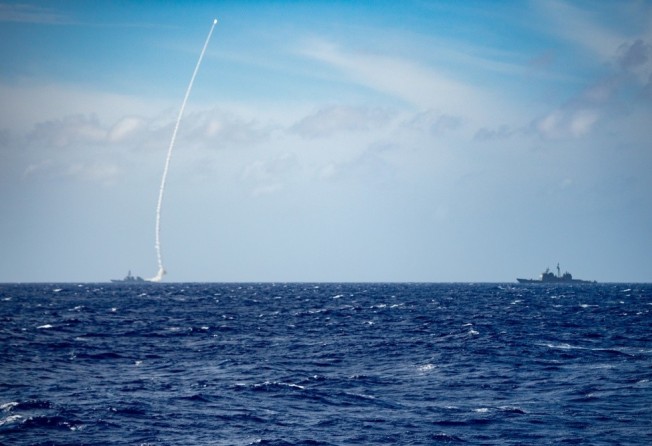US Navy launches live-fire missiles in ‘warning to China’
- Unusual drill in the Philippine Sea a signal to the PLA that American forces can counter advanced threats, military observers say
- Exercise designed to support ‘security and stability in the Indo-Pacific’

The US Navy was targeting China with live-fire missile tests in the Philippine Sea last week, sending a message that it was up to the challenge of the PLA’s new advanced systems, military analysts said.
In the drill in waters east of the Philippines on Thursday, the guided-missile destroyer USS Barry launched a medium-range Standard Missile-2, the US Seventh Fleet said on its Facebook page.
It was accompanied by the guided-missile cruiser USS Shiloh, which also launched an SM-2 during the drill.
Beijing-based military specialist Zhou Chenming said these kinds of drill were not common and “could be seen as a warning to the People’s Liberation Army”.
“The US Navy is worried about Chinese missiles, which China could use as a trump card in a military conflict between the two parties in the region. The Seventh Fleet wants to warn Beijing that it can intercept missiles from China,” Zhou said.
Li Jie, another Beijing-based military analyst, agreed that the launches were a message to China – and to a lesser extent, Russia.
“The US Navy wants to tell China that they can counter the PLA’s advanced missiles,” Li said.
The PLA has developed two kinds of missiles that could pose big threats to the US military – the “carrier killer” DF-21D and the anti-ship DF-26, which has a 4,000km (2,500-mile) range and puts the US naval base in Guam within reach.
Either one of the missiles might have been put through its paces in June when the PLA Rocket Force staged missile tests in the disputed South China Sea, according to the Pentagon.
The USS Barry was retrofitted with the latest Aegis combat system two years ago, improving its ability to defend bases such as Guam and US warships from the two kinds of Chinese missiles.
Further US upgrades and tests can be expected, as the PLA tries to narrow the hardware, software and training gap with the American military, according to Collin Koh Swee Lean, a research fellow with the Institute of Defence and Strategic Studies’ Maritime Security Programme in Singapore.
“Given the shift in defence focus to the Indo-Pacific and with the PLA threat in mind, I wouldn’t be surprised if the US Navy conducted more such live-fire exercises to validate the fleet’s capabilities against the evolving PLA missile strength,” Koh said, adding that the Philippine Sea would be a significant battlefield in any future China-US armed conflict.
The missile launches come as the US strengthens military links with Vietnam, the Philippines and other regional allies as part of its Indo-Pacific strategy to curb China’s power in the South China Sea.
The Seventh Fleet said the Barry’s live-fire operation was in support of security and stability in the Indo-Pacific.
Hong Kong-based military commentator Song Zhongping said the drill in the Philippine Sea was meant to strengthen the US military presence in the region, amid fears that the US could be forced out by the PLA.
“The Philippine Sea is also the critical maritime artery for PLA vessels when they sail to the western Pacific and Indian oceans,” Song said. “The US Navy needs to further enhance its military presence in the region, signalling that political trust between the two countries is falling.”
Purchase the China AI Report 2020 brought to you by SCMP Research and enjoy a 20% discount (original price US$400). This 60-page all new intelligence report gives you first-hand insights and analysis into the latest industry developments and intelligence about China AI. Get exclusive access to our webinars for continuous learning, and interact with China AI executives in live Q&A. Offer valid until 31 March 2020.